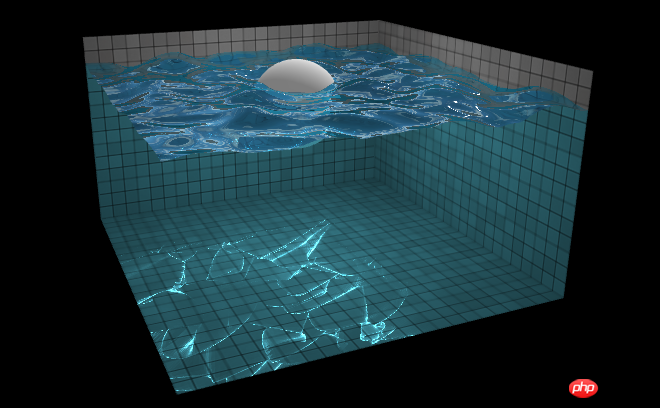
Il s'agit d'un effet spécial d'animation de vagues d'eau 3D basé sur HTML5. Son effet est très réaliste. Les pierres de la piscine coulent et flottent dans l'eau, créant des couches de vagues d'eau. En même temps, nous pouvons faire glisser la souris pour parcourir la piscine sous différents angles, et l'effet 3D est très bon. De plus, nous pouvons appuyer sur la touche « G » pour faire flotter les pierres de la piscine de haut en bas, et appuyer sur la touche « L » pour ajouter des effets de lumière. Le design est tout à fait parfait. En même temps, permettez-moi de vous expliquer que cette animation de vagues d'eau 3D est basée sur la technologie de rendu WebGL. Vous pouvez en apprendre davantage sur WebGL.

Téléchargement du code source de la démo en ligne
Code HTML
<img id="tiles" src="tiles.jpg"> <img id="xneg" src="xneg.jpg"> <img id="xpos" src="xpos.jpg"> <img id="ypos" src="ypos.jpg"> <img id="zneg" src="zneg.jpg"> <img id="zpos" src="zpos.jpg">
Code JavaScript
function Water() {
var vertexShader = '\
varying vec2 coord;\
void main() {\
coord = gl_Vertex.xy * 0.5 + 0.5;\
gl_Position = vec4(gl_Vertex.xyz, 1.0);\
}\
';
this.plane = GL.Mesh.plane();
if (!GL.Texture.canUseFloatingPointTextures()) {
throw new Error('This demo requires the OES_texture_float extension');
}
var filter = GL.Texture.canUseFloatingPointLinearFiltering() ? gl.LINEAR : gl.NEAREST;
this.textureA = new GL.Texture(256, 256, { type: gl.FLOAT, filter: filter });
this.textureB = new GL.Texture(256, 256, { type: gl.FLOAT, filter: filter });
this.dropShader = new GL.Shader(vertexShader, '\
const float PI = 3.141592653589793;\
uniform sampler2D texture;\
uniform vec2 center;\
uniform float radius;\
uniform float strength;\
varying vec2 coord;\
void main() {\
/* get vertex info */\
vec4 info = texture2D(texture, coord);\
\
/* add the drop to the height */\
float drop = max(0.0, 1.0 - length(center * 0.5 + 0.5 - coord) / radius);\
drop = 0.5 - cos(drop * PI) * 0.5;\
info.r += drop * strength;\
\
gl_FragColor = info;\
}\
');
this.updateShader = new GL.Shader(vertexShader, '\
uniform sampler2D texture;\
uniform vec2 delta;\
varying vec2 coord;\
void main() {\
/* get vertex info */\
vec4 info = texture2D(texture, coord);\
\
/* calculate average neighbor height */\
vec2 dx = vec2(delta.x, 0.0);\
vec2 dy = vec2(0.0, delta.y);\
float average = (\
texture2D(texture, coord - dx).r +\
texture2D(texture, coord - dy).r +\
texture2D(texture, coord + dx).r +\
texture2D(texture, coord + dy).r\
) * 0.25;\
\
/* change the velocity to move toward the average */\
info.g += (average - info.r) * 2.0;\
\
/* attenuate the velocity a little so waves do not last forever */\
info.g *= 0.995;\
\
/* move the vertex along the velocity */\
info.r += info.g;\
\
gl_FragColor = info;\
}\
');
this.normalShader = new GL.Shader(vertexShader, '\
uniform sampler2D texture;\
uniform vec2 delta;\
varying vec2 coord;\
void main() {\
/* get vertex info */\
vec4 info = texture2D(texture, coord);\
\
/* update the normal */\
vec3 dx = vec3(delta.x, texture2D(texture, vec2(coord.x + delta.x, coord.y)).r - info.r, 0.0);\
vec3 dy = vec3(0.0, texture2D(texture, vec2(coord.x, coord.y + delta.y)).r - info.r, delta.y);\
info.ba = normalize(cross(dy, dx)).xz;\
\
gl_FragColor = info;\
}\
');
this.sphereShader = new GL.Shader(vertexShader, '\
uniform sampler2D texture;\
uniform vec3 oldCenter;\
uniform vec3 newCenter;\
uniform float radius;\
varying vec2 coord;\
\
float volumeInSphere(vec3 center) {\
vec3 toCenter = vec3(coord.x * 2.0 - 1.0, 0.0, coord.y * 2.0 - 1.0) - center;\
float t = length(toCenter) / radius;\
float dy = exp(-pow(t * 1.5, 6.0));\
float ymin = min(0.0, center.y - dy);\
float ymax = min(max(0.0, center.y + dy), ymin + 2.0 * dy);\
return (ymax - ymin) * 0.1;\
}\
\
void main() {\
/* get vertex info */\
vec4 info = texture2D(texture, coord);\
\
/* add the old volume */\
info.r += volumeInSphere(oldCenter);\
\
/* subtract the new volume */\
info.r -= volumeInSphere(newCenter);\
\
gl_FragColor = info;\
}\
');
}
Water.prototype.addDrop = function(x, y, radius, strength) {
var this_ = this;
this.textureB.drawTo(function() {
this_.textureA.bind();
this_.dropShader.uniforms({
center: [x, y],
radius: radius,
strength: strength
}).draw(this_.plane);
});
this.textureB.swapWith(this.textureA);
};
Water.prototype.moveSphere = function(oldCenter, newCenter, radius) {
var this_ = this;
this.textureB.drawTo(function() {
this_.textureA.bind();
this_.sphereShader.uniforms({
oldCenter: oldCenter,
newCenter: newCenter,
radius: radius
}).draw(this_.plane);
});
this.textureB.swapWith(this.textureA);
};
Water.prototype.stepSimulation = function() {
var this_ = this;
this.textureB.drawTo(function() {
this_.textureA.bind();
this_.updateShader.uniforms({
delta: [1 / this_.textureA.width, 1 / this_.textureA.height]
}).draw(this_.plane);
});
this.textureB.swapWith(this.textureA);
};
Water.prototype.updateNormals = function() {
var this_ = this;
this.textureB.drawTo(function() {
this_.textureA.bind();
this_.normalShader.uniforms({
delta: [1 / this_.textureA.width, 1 / this_.textureA.height]
}).draw(this_.plane);
});
this.textureB.swapWith(this.textureA);
}; Ce qui précède est le contenu de l'animation réaliste de vagues d'eau 3D HTML5 qui peut être parcourue sous plusieurs perspectives avec des graphiques et du texte de code. Pour plus de contenu connexe, veuillez prêter attention au site Web PHP chinois (www.php.cn) !
 Quelles sont les méthodes de production de production d'animation html5 ?
Quelles sont les méthodes de production de production d'animation html5 ?
 La différence entre HTML et HTML5
La différence entre HTML et HTML5
 Comment récupérer des fichiers vidés de la corbeille
Comment récupérer des fichiers vidés de la corbeille
 Solution à l'absence de son dans le système Win7
Solution à l'absence de son dans le système Win7
 Introduction à l'utilisation du serveur FTP
Introduction à l'utilisation du serveur FTP
 gt540
gt540
 Code écran bleu de l'ordinateur 0xc0000225
Code écran bleu de l'ordinateur 0xc0000225
 Outils courants pour les tests de logiciels
Outils courants pour les tests de logiciels
 Dogecoin prix d'aujourd'hui
Dogecoin prix d'aujourd'hui